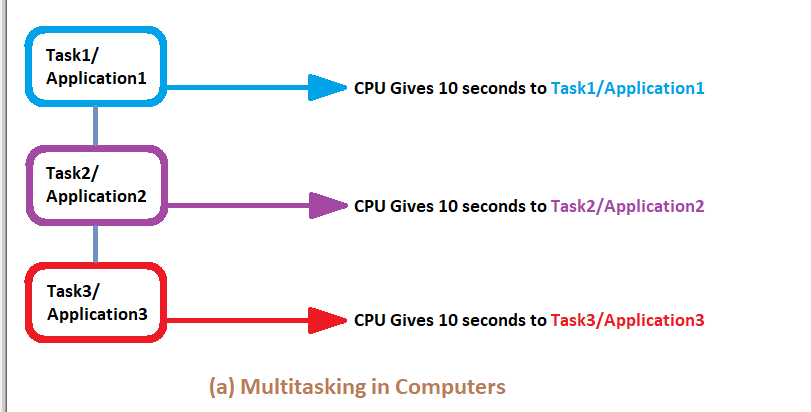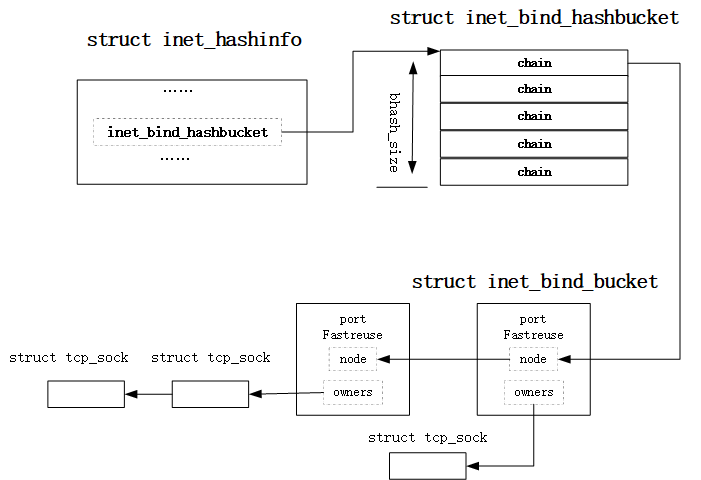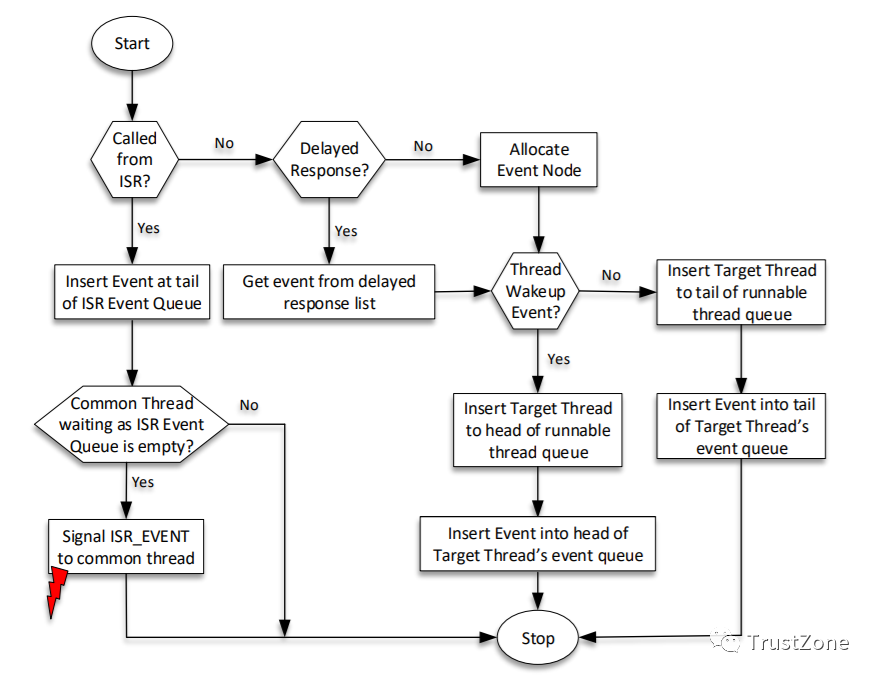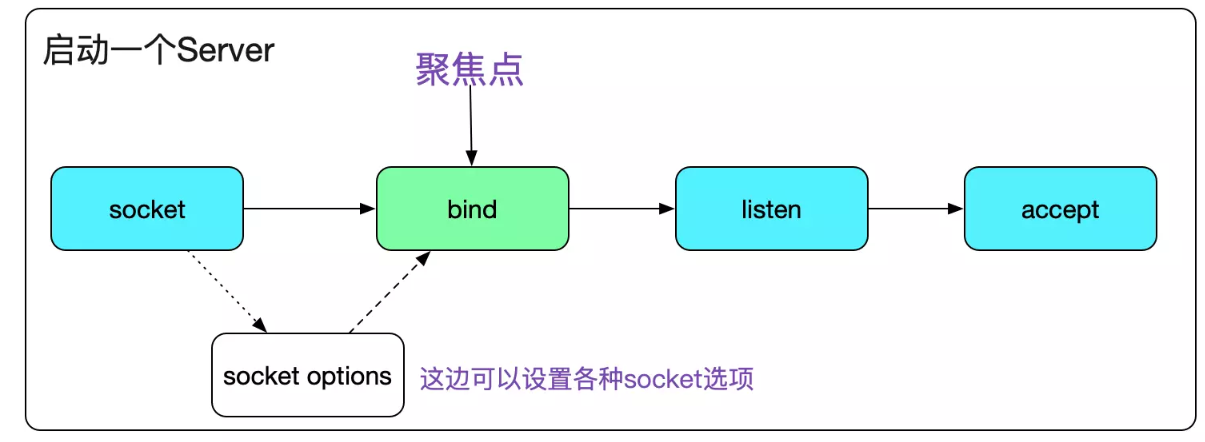bind的核心執(zhí)行函數(shù)
bind系統(tǒng)調(diào)用的核心函數(shù)調(diào)用流程如下:
SYSCALL_DEFINE3(bind, int, fd, struct sockaddr __user *, umyaddr, int, addrlen)
|
sock- >ops- >bind(sock,
(struct sockaddr *)
&address, addrlen);
|
inet_bind
|
inet_csk_get_port
中間的流程暫且不看,本文主要分析最重要的函數(shù):inet_csk_get_port,從該函數(shù)出發(fā)了解本地綁定端口如何管理。
以下是原函數(shù),通過下文章節(jié)逐步分段分析
int inet_csk_get_port(struct sock *sk, unsigned short snum)
{
bool reuse = sk- >sk_reuse && sk- >sk_state != TCP_LISTEN;
struct inet_hashinfo *hinfo = sk- >sk_prot- >h.hashinfo;
int ret = 1, port = snum;
struct inet_bind_hashbucket *head;
struct net *net = sock_net(sk);
struct inet_bind_bucket *tb = NULL;
kuid_t uid = sock_i_uid(sk);
if (!port) {
head = inet_csk_find_open_port(sk, &tb, &port);
if (!head)
return ret;
if (!tb)
goto tb_not_found;
goto success;
}
head = &hinfo- >bhash[inet_bhashfn(net, port,
hinfo- >bhash_size)];
spin_lock_bh(&head- >lock);
inet_bind_bucket_for_each(tb, &head- >chain)
if (net_eq(ib_net(tb), net) && tb- >port == port)
goto tb_found;
tb_not_found:
tb = inet_bind_bucket_create(hinfo- >bind_bucket_cachep,
net, head, port);
if (!tb)
goto fail_unlock;
tb_found:
if (!hlist_empty(&tb- >owners)) {
if (sk- >sk_reuse == SK_FORCE_REUSE)
goto success;
if ((tb- >fastreuse > 0 && reuse) ||
sk_reuseport_match(tb, sk))
goto success;
if (inet_csk_bind_conflict(sk, tb, true, true))
goto fail_unlock;
}
success:
if (hlist_empty(&tb- >owners)) {
tb- >fastreuse = reuse;
if (sk- >sk_reuseport) {
tb- >fastreuseport = FASTREUSEPORT_ANY;
tb- >fastuid = uid;
tb- >fast_rcv_saddr = sk- >sk_rcv_saddr;
tb- >fast_ipv6_only = ipv6_only_sock(sk);
tb- >fast_sk_family = sk- >sk_family;
#if IS_ENABLED(CONFIG_IPV6)
tb- >fast_v6_rcv_saddr = sk- >sk_v6_rcv_saddr;
#endif
} else {
tb- >fastreuseport = 0;
}
} else {
if (!reuse)
tb- >fastreuse = 0;
if (sk- >sk_reuseport) {
if (!sk_reuseport_match(tb, sk)) {
tb- >fastreuseport = FASTREUSEPORT_STRICT;
tb- >fastuid = uid;
tb- >fast_rcv_saddr = sk- >sk_rcv_saddr;
tb- >fast_ipv6_only = ipv6_only_sock(sk);
tb- >fast_sk_family = sk- >sk_family;
#if IS_ENABLED(CONFIG_IPV6)
tb- >fast_v6_rcv_saddr = sk- >sk_v6_rcv_saddr;
#endif
}
} else {
tb- >fastreuseport = 0;
}
}
if (!inet_csk(sk)- >icsk_bind_hash)
inet_bind_hash(sk, tb, port);
WARN_ON(inet_csk(sk)- >icsk_bind_hash != tb);
ret = 0;
fail_unlock:
spin_unlock_bh(&head- >lock);
return ret;
}
聲明:本文內(nèi)容及配圖由入駐作者撰寫或者入駐合作網(wǎng)站授權(quán)轉(zhuǎn)載。文章觀點(diǎn)僅代表作者本人,不代表電子發(fā)燒友網(wǎng)立場(chǎng)。文章及其配圖僅供工程師學(xué)習(xí)之用,如有內(nèi)容侵權(quán)或者其他違規(guī)問題,請(qǐng)聯(lián)系本站處理。
舉報(bào)投訴
-
Linux
+關(guān)注
關(guān)注
87文章
11345瀏覽量
210409 -
函數(shù)
+關(guān)注
關(guān)注
3文章
4346瀏覽量
62978 -
系統(tǒng)
+關(guān)注
關(guān)注
1文章
1019瀏覽量
21431
發(fā)布評(píng)論請(qǐng)先 登錄
相關(guān)推薦
linux中的busybox,是否帶有bind和ifenslave?
想問下,飛凌提供的linux中的busybox,是否帶有bind和ifenslave?如果沒有有什么辦法可以添加?
發(fā)表于 01-11 06:53
Bind源代碼包安裝
先到官方下載Bind的安裝包 wgetftp://ftp.isc.org/isc/bind9/9.6.0-P1/bind-9.6.0-P1.tar.gz tar xzvf
發(fā)表于 04-04 20:30
?23次下載
linux c函數(shù)庫參考手冊(cè)_徐千洋
書中整理了超過400個(gè)Linux常用的函數(shù),每個(gè)函數(shù)以整齊劃一的體例列出了函數(shù)名稱、相關(guān)函數(shù)、使用的表頭文件、
發(fā)表于 11-29 17:12
?0次下載
Linux教程之Linux C函數(shù)參考教程免費(fèi)下載
本文檔的主要內(nèi)容詳細(xì)介紹的是Linux教程之Linux C函數(shù)參考教程免費(fèi)下載。
發(fā)表于 03-20 08:00
?4次下載

Linux下進(jìn)程的創(chuàng)建、執(zhí)行和終止
許多操作系統(tǒng)提供的都是產(chǎn)生進(jìn)程的機(jī)制,也就是說,首先在新的地址空間里創(chuàng)建進(jìn)程、讀入可執(zhí)行文件,后再開始執(zhí)行。Linux中進(jìn)程的創(chuàng)建很特別,它把上述步驟分解到兩個(gè)單獨(dú)的函數(shù)中去
發(fā)表于 06-11 09:21
?641次閱讀
如何使用Arduino millis函數(shù)執(zhí)行多任務(wù)處理
在本教程中,我們將學(xué)習(xí)Arduino 如何使用 Arduino millis 函數(shù)執(zhí)行多任務(wù)處理。通常在 Arduino 中使用delay()函數(shù)來執(zhí)行LED 閃爍等周期性任務(wù),但此

什么是bind?你真的熟悉bind嗎?
bind()方法創(chuàng)建一個(gè)新的函數(shù),在bind()被調(diào)用時(shí),這個(gè)新函數(shù)的this被指定 bind()的第一個(gè)參數(shù),而其余參數(shù)將作為新
bind系統(tǒng)調(diào)用背后的端口管理復(fù)用
的bind系統(tǒng)調(diào)用進(jìn)行分析,主要是了解一下bind背后,Linux內(nèi)核是如何進(jìn)行端口綁定、如何管理本地眾多的端口號(hào)。 先直觀感受bind系統(tǒng)調(diào)用背后的端口管理、端口復(fù)用 # inclu

Linux內(nèi)核分析 端口哈希桶
是用來封裝各種協(xié)議的綁定哈希表,具體定義如下所示,這個(gè)結(jié)構(gòu)體在[Linux內(nèi)核角度分析服務(wù)器Listen細(xì)節(jié)中介紹過,具體地,struct inet_bind_hashbcket是bind相關(guān)的哈希桶

Linux內(nèi)核分析 bind端口選擇
端口選擇 繼續(xù)看inet_csk_get_port函數(shù): 在端口選擇前, 先確定當(dāng)前該socket的“屬性”,即是否可以端口復(fù)用,是否在TCP_LISTEN狀態(tài),以便后面插入到桶隊(duì)列時(shí)設(shè)置
SCP固件執(zhí)行步驟和模塊間通信
SCP固件執(zhí)行步驟 運(yùn)行前階段:按固定順序排列的5個(gè)階段 ? 模塊初始化:框架使用模塊配置數(shù)據(jù)調(diào)用的模塊的.init()函數(shù)。 ? 元素初始化:帶有元素配置數(shù)據(jù)的框架調(diào)用的模塊





 Linux bind的核心執(zhí)行函數(shù)
Linux bind的核心執(zhí)行函數(shù)












評(píng)論